서 론
양묘과정에서 고품질 묘목 생산은 이어지는 조림 성과에 직접적 영향을 미치며(Dumroese et al., 2016), 이러한 묘목품질은 생존 및 생장 잠재력에 영향을 미칠 수 있는 형태학적, 생리학적 특성을 포함한다(Haase, 2008). 조림 후 생존 및 생장 잠재력을 증가시키기 위한 묘목을 생산하기 위해서는 양묘과정에서 최적 광, 온도, 수분, 양분 등의 생육환경을 조성하는 양묘기술이 적용되어야 하며(Aghai et al., 2014), 묘목 굴취, 검사, 포장, 저장, 운반, 해동 등의 조림 전 묘목 수확 후 관리 기술도 중요한 과정이다(Ritchie, 1989).
봄에 조림되는 산림용 묘목의 월동은 일반적으로 야외에서 방풍벽 등 구조물을 이용하여 이루어졌다. 그러나 최근 지구온난화의 영향에 따른 봄철 묘목 생산지(양묘장)와 조림지의 기온 차이, 겨울철 월동과정에서 돌발성 한파, 한건풍 등 기상이변, 늦겨울과 초봄 토양이 해동하지 않은 상태에서 기온 상승에 따른 묘목 건조 등에 의해 묘목 월동 및 식재 과정에서 많은 묘목 피해가 발생하고 있다(Kim et al., 2010a; Kim et al., 2010b).
국외에서는 묘목품질 및 작업 효율성 향상을 위해 묘목 저온저장이 양묘과정에서 필수 시업 과정으로 확립되었으며(Ritchie, 1987), 기후변화에 의해 그 중요성이 더 커지고 있는 실정이다. 우리나라도 최근 기후변화 등 양묘 및 조림 여건 변화에 따라 저온 저장시설(refrigerator)을 활용한 묘목 저온저장 월동 방식이 양묘 현장에서 증가하고 있으며, 산림청에서도 2015년부터 조림 전 묘목품질 향상과 조림성과 제고를 위해 양묘시설 현대화 사업을 통한 저온 저장시설 구축을 추진하고 있다(KFS, 2021). 그러나 현재까지 우리나라는 구조물을 이용한 월동 연구(Kim et al., 2018)를 제외하고 저장시설을 활용한 산림용 묘목 저온저장 연구는 수행되지 않았다. 따라서 수종별 특성에 맞는 저온저장 조건 구명 및 과학적 기준 정립이 이루어져야 하며, 기후변화 영향으로 발생하는 양묘 및 조림 현장의 문제를 해결하기 위해 묘목의 저장 관련 관리 기술 개발 연구가 필요한 시점이다.
묘목의 저온저장은 우량 묘목을 원하는 시기에 조림하기 위해 봄 또는 가을에 생장이 정지된 묘목을 포장하여 저온 저장시설에서 수종별 저장 기간 및 온도 설정에 따라 조림 전까지 저장하는 것을 말한다. 저온저장의 장점은 조림 시기 확대 및 조림 성과 향상, 포지 및 온실 이용의 효율성 향상, 월동과정에서 기후변화에 따른 돌발성 묘목 피해 방지, 봄철 양묘장 집중 작업(묘목 굴취, 검사, 파종 등) 인력 분산 가능, 묘목 포장의 규격화 및 운반의 용이성 향상 등이 있다(Landis et al., 2010; Cho et al., 2017).
산림용 묘목 저장은 굴취, 검사, 포장, 해동, 운반과 연계되어 있으며, 각각의 과정에서 묘목품질이 변화될 수 있다(Grossnickle et al., 2020). 즉, 조림 전 묘목 수확 관리 시스템은 하나로 이루어지는 과정이다. 이러한 조림 전 묘목 수확 관리 중 묘목 저온저장이 중심에 있으며, 이외 과정은 저온저장 조건에 따라 적용기술이 같이 발전되었다. 저온저장 과정 중 묘목 건조, 동아 트임, 탄수화물 저감, 곰팡이균 발생 등의 묘목품질 변화를 최소화하기 위해서 포장 기술이 적용되었으며(Kooistra and Backer, 2005), 운반과 해동 과정도 묘목 식재 전 최상의 품질을 유지하기 위한 기술이 적용되고 있다(Kerr, 1994; Rose and Haase 1997). 따라서 조림 전 최상의 묘목품질 유지를 위한 묘목 수확 관리 시스템 구축을 위해서는 수종별 저장 기간, 온도 등 최적 저온저장 조건 구명이 선행되어야 한다.
산림용 묘목의 저온저장은 온도와 기간에 따라 생리적 특성에 영향을 미쳐 품질의 변화가 나타난다(McKay and White, 1997; Luoranen et al., 2019). 특히, 저온저장에 대한 반응은 월동기간 동안 잎의 존재에 따른 상록수와 낙엽수 간에 차이를 보이며, 뿌리 노출 차이에 따른 노지묘와 용기묘의 저온저장 반응이 다르게 나타난다(Davis, 1994; Mena-Petite et al., 2001). 일반적으로 잎의 호흡량이 증가하는 상록수와 뿌리가 노출된 노지묘가 저온저장 저항성이 약한 것으로 보고되고 있으며(Martens et al., 2007), 수종, 묘목 종류 등의 차이에 따라 저온저장 기술이 다르게 적용되어야 한다.
묘목 저온저장 온도 조건은 유지 호흡에 영향을 미치며, 이는 저장된 탄수화물의 소비와 연계되어 묘목품질의 변화를 가져온다(Ritchie, 1982). 특히, 저장 중에도 묘목은 낮은 수준이지만 여전히 생리 활동을 하고 있으며, 저장 기간이 길어짐에 따라 건조에 의한 묘목 마름 문제뿐만 아니라(Grossnickle and South, 2014), 내한성, 뿌리생장잠재력 및 탄수화물 함량이 감소한다(Grossnickle et al., 1994; Camm et al., 1995). 이는 저장과정 후 발현될 묘목품질의 잠재적 능력과 지속적인 상관을 보이면서 최종적으로 조림 후 활착률 및 생장 감소로 이어진다(Mattsson and Troeng, 1986; Radoglou and Raftoyannis, 2002).
이에 본 연구는 묘목의 저온저장 기술과 관련하여, 온대 주요 낙엽 활엽수 조림 수종인 굴참나무와 느티나무 노지묘 및 용기묘를 대상으로 저온저장 온도와 기간에 따른 묘목의 생리 및 생장 특성을 조사하여, 묘목품질 변화에 미치는 영향을 구명하고, 최적의 묘목 저온저장 기준을 제시하고자 수행하였다.
재료 및 방법
본 연구에서 사용된 공시수종은 굴참나무(Quercus variabilis)와 느티나무(Zelkova serrata) 노지묘 및 용기묘 1-0묘이다. 국립산림품종관리센터에서 분양받은 채종원산 종자를 이용하였으며, 경기도 포천에 위치한 국립산림과학원 산림기술경영연구소 노지 포지 및 시설온실(N 37˚ 45’, E 127˚10’)에서 시험 묘목을 각각 생산하였다. 노지묘와 용기묘 모두 2018년 4월 종자를 파종하였으며, 파종량, 용기, 상토, 관수, 시비 등 모든 양묘시업은 산림청 종묘사업실시요령(KFS, 2017) 기준으로 실시하였다. 2018년 12월 생산된 묘목을 수확하여 저온저장 처리를 실시하였으며, 용기묘의 경우 저장 전 1개월 간 경화 처리하였다. 저온저장 전 수종별 묘목 규격은 Table 1과 같다.
| Species | Stock type | Root collar diameter (mm) | Height (cm) |
|---|---|---|---|
| Q. variabilis | Bare-root | 4.2±0.5 | 31.3±6.9 |
| Container | 3.9±0.2 | 34.9±4.7 | |
| Z. serrata | Bare-root | 4.1±0.6 | 44.3±7.3 |
| Container | 4.3±0.4 | 48.3±5.4 |
Values are means of 90 seedlings±SD.
2018년 12월 굴참나무와 느티나무는 노지묘와 용기묘로 분류하여, 상자 당 150본씩 종이상자 내부에 보호필름으로 이중 포장하였다. 저온저장 처리는 국외에서 적용되는 저온저장 온도 및 기간 기준(Landis et al., 2010)을 토대로 설계하였으며, 2가지 저장 온도(냉동 −2°C, 냉장 2°C)에서 9가지 저장 기간(0, 15, 30, 60, 120, 180, 240, 300, 360일) 처리를 실시하였다. 2018년 12월에 수종, 묘목 종류 및 저장 온도에 따라 3반복, 총 24개(0일, 대조구 제외) 상자를 저온 저장고(Daesung Maref Co. Ltd., Korea)에 위치하여 처리를 시작하였다. 저장기간 동안 냉동은 온도 −2±0.3°C와 상대습도 63.7±1.4%, 냉장은 온도 2±0.3°C와 상대습도 65.2±2.8% 범위를 유지하였다.
저온저장 후 묘목품질의 변화를 조사하기 위해 9가지 저장 기간 중 4가지 기간(30, 60, 180, 360일)을 선정하여 각각의 저장 기간 종료 후 상자 당 20본씩 총 60본의 묘목을 용기에 식재하였다. 저장 기간별 묘목 식재 후 생육환경을 동일하게 유지하기 위해서 생장상(Hanbaek Co. Ltd., Korea)에서 총 150일 동안 생육하였으며, 생장상의 생육환경은 Table 2와 같이 조성하였다.
| Time (h) | Light intensity (μmol m−2 s−1) | Relative humidity (%) | Irrigation (L m−2 day−1) | Fertilization (g L−1 week−1) |
|---|---|---|---|---|
| 06-08 | 800 | 50 | 20 | 1 |
| 08-10 | 1200 | 60 | ||
| 10-14 | 1600 | 70 | ||
| 14-16 | 1000 | 60 | ||
| 16-18 | 400 | 50 | ||
| 18-06 | 0 | 40 |
Fertilization was carried out 12 times from 30 days after seedling planting.
온도 및 저장 기간에 따른 저장과정 중 묘목품질 변화를 조사하기 위해 9가지 저장 기간별 포장상자 당 3본씩 총 9본의 묘목을 선정하여 비구조성탄수화물(Total nonstructural carbohydrate; TNC) 함량, 줄기함수율(Shoot moisture content; SMC)을 조사하였다. 선정된 묘목을 줄기, 뿌리로 구분하여 생중량을 측정하였으며, 65°C의 건조기에서 48시간 동안 건조한 후 건중량을 측정하였다. 비구조성탄수화물 분석은 건조된 시료 0.1 g에 혼합 추출액(methanol : chloroform : H2O = 12 : 5 : 3) 1.5 mℓ를 섞은 후, 60초간 원심분리를 실시하고, 상등액 0.1 mℓ을 포도당과 과당 분석에 사용하였으며, 침전물은 전분 분석을 위해 남은 액체를 건조기를 이용하여 건조시켰다. 탄수화물 함량은 glucose oxidase법(Hendry and Grime, 1993)을 이용하였으며, 460 nm의 파장에서 흡광도를 측정하여 결정하였다. Paynter et al.(1991)의 방법에 따라 총비구조성탄수화물 함량을 계산하였다. 또한, 줄기함수율[SMC = (Shoot fresh weight - Shoot dry weight) / Shoot dry weight × 100]을 산출하였다(McKay and White, 1997).
온도 및 저장 기간에 따른 식재 후 묘목품질 변화를 조사하기 위해 처리별 식재된 60본의 묘목에 대해 식재 150일 후 생존율을 조사하였다. 또한, 처리별 무작위로 9본을 선정하여, 65°C의 건조기에서 48시간 동안 건조한 후 묘목 건중량을 측정하였다.
저온저장 온도 및 기간 처리에 따른 묘목품질을 비교·분석하기 위해서 SAS 9.4(SAS Institute Inc., USA)와 Sigmaplot 14(Systat Software Inc., USA) 프로그램를 이용하였다. 묘목 종류, 저장 온도, 저장 기간에 관한 삼원분산분석(Three-way ANOVA)을 실시하였으며, 저온저장 처리에 따른 유의성 분석을 위해 다중검정법(Duncan’s Multiple comparison)을 이용하였고, 저장 기간 일수 증가에 따른 묘목품질의 감소율을 분석하기 위해 회귀분석(Regression analysis)을 실시하였다.
결과 및 고찰
굴참나무와 느티나무의 묘목 종류, 저장 온도, 기간 등 3가지 요인에 따른 비구조성탄수화물과 줄기함수율의 삼원분산분석 결과, 두 수종 모두 뿌리, 줄기 및 묘목의 비구조성탄수화물은 3가지 요인 각각에 따른 유의적 차이와 2가지 또는 3가지 요인의 상호작용이 확인되었다. 그러나 두 수종 모두 줄기함수율은 묘목 종류, 저장 온도 기간별 통계적 차이는 있었지만, 요인간 처리에 따른 상호작용은 없었다(Table 3).
Figure 1은 저온저장 온도 및 기간에 따른 굴참나무, 느티나무 노지묘와 용기묘의 비구조성탄수화물 함량 변화 및 회귀식을 나타내고 있다. 두 수종의 노지묘와 용기묘 모두 저장 기간에 길어질수록 비구조성탄수화물 함량이 감소하였으며, 냉동(−2°C)보다 냉장(2°C) 저장에서 감소율이 높게 나타났다. 묘목 종류에 따른 감소율은 느티나무 냉동 저장을 제외하고 대부분 노지묘보다 용기묘가 낮았다. 즉, 묘목 저온저장 기간이 길어질수록 용기묘와 냉동 저장이 노지묘와 냉장 저장 조건보다 저장에 대한 적응성이 높게 나타난 기존의 연구들과 유사한 결과를 보였다(Mckay, 1996; Radoglou and Raftoyannis, 2002; Grossnickle and EL-Kassaby, 2016).
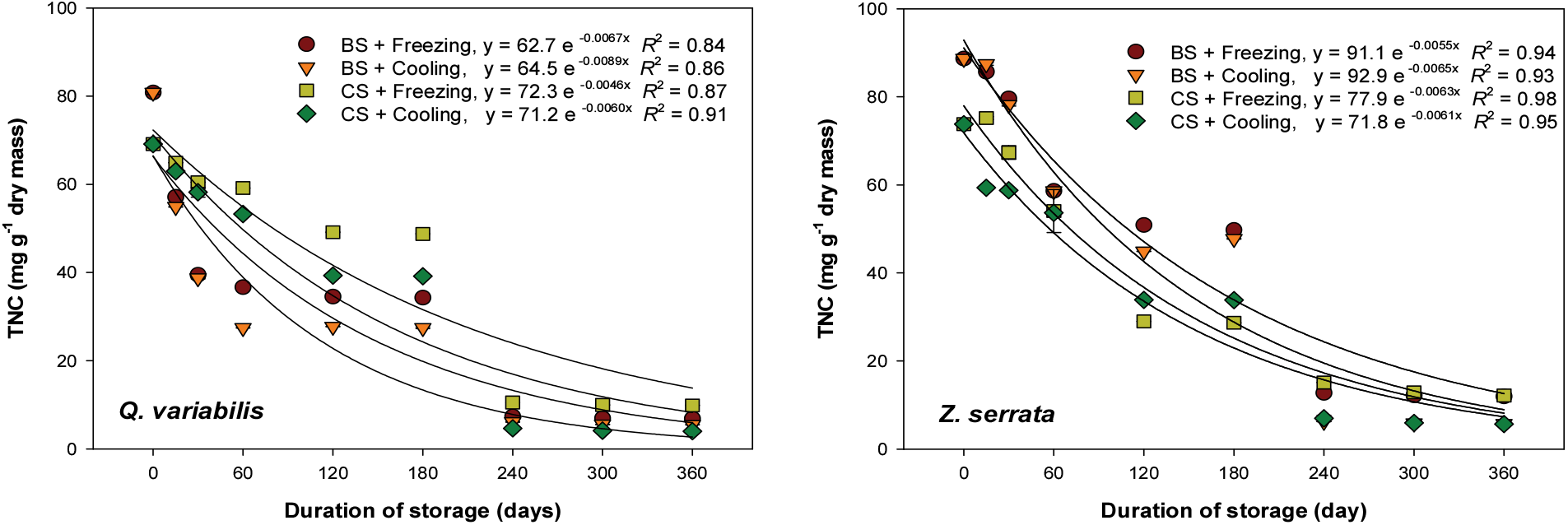
국외에서 산림용 묘목의 저장은 일반적으로 기간에 따라 2개월 미만은 냉장(1~2°C), 2~8개월 동안은 냉동(−2 ~−4°C) 저장을 실시하며(Landis et al., 2010), 저장 온도가 −5°C 이하로 떨어지면 묘목 뿌리 손상이 나타난다(Bigras, 1997). 저장 기간이 길어질수록 뿌리생장잠재력(root growth potential) 및 탄수화물 감소(Grossnickle and South, 2014), 곰팡이균(Botrytis cinerea) 발생(Petaisto, 2006) 등과 함께 식재 후 묘목 활착 및 생장(Martens et al., 2007) 등에 부정적 문제가 발생할 수 있으며, 이를 고려하여 6개월 미만의 저장을 권장한다(Grossnickle et al., 2020). 본 연구에서도 묘목 저장 시작 후 저장 전 대비 비구조성탄수화물 함량이 약 20~55 mg g−1 감소하다가 60~180일 기간에는 일정하게 유지되고, 이후 180~240일에서 급격히 감소하여 15 mg g−1 미만의 비구조성성탄수화물 함량을 보여주고 있다. 이러한 결과는 비구조성탄수화물 함량이 급격하게 변하는 2개월과 6개월을 기준으로 산림용 묘목을 저장 가능 기간과 기간별 온도 등 저장 방식 기준의 근거를 제시할 수 있다.
굴참나무는 용기묘, 느티나무는 노지묘가 저장에 따라 다른 묘목 종류보다 비구조성탄수화물 함량이 높았다(Figure 2A). 또한, 두 수종 모두 냉장(2°C)보다 냉동(−2°C) 저장에서 높은 비구조성탄수화물 함량을 보였으며(Figure 2B), 저장 기간이 길어질수록 비구조성탄수화물 함량이 유의적으로 낮아지는 경향을 나타냈다(Figure 2C). 이러한 묘목 종류, 저장 온도 및 기간에 따른 비구조성탄수화물의 변화는 묘목품질의 잠재적 지표이며, 식재 후 묘목 활착 및 생장 결과와 연계된다(Villar-Salvador et al., 2015). 미송(Pseudotsuga menziesii)은 저온저장 기간의 증가로 인한 비구조성탄수화물 감소가 조림 후 생존율 저하로 이어졌으며(Ritchie, 1982), 소나무(Pinus radiata) (Mena-Petite et al., 2001), 미송(Pseudotsuga menziesii)과 가문비나무(Picea sitchensis)(Cannell et al., 1990), 활엽수 9수종(Acer pseudoplatamus, Catalpa bignonioides, Celtis siliquastrum, Fraxinus ornus, Hibiscus syriacus, Koelreuteria paniculata, Platanus orientlis, Sophora japonica)(Radoglou and Raftoyannis, 2002), 사시나무(Populus tremuloides)(Martens et al., 2007) 등의 연구에서도 같은 결과가 보고되었다.
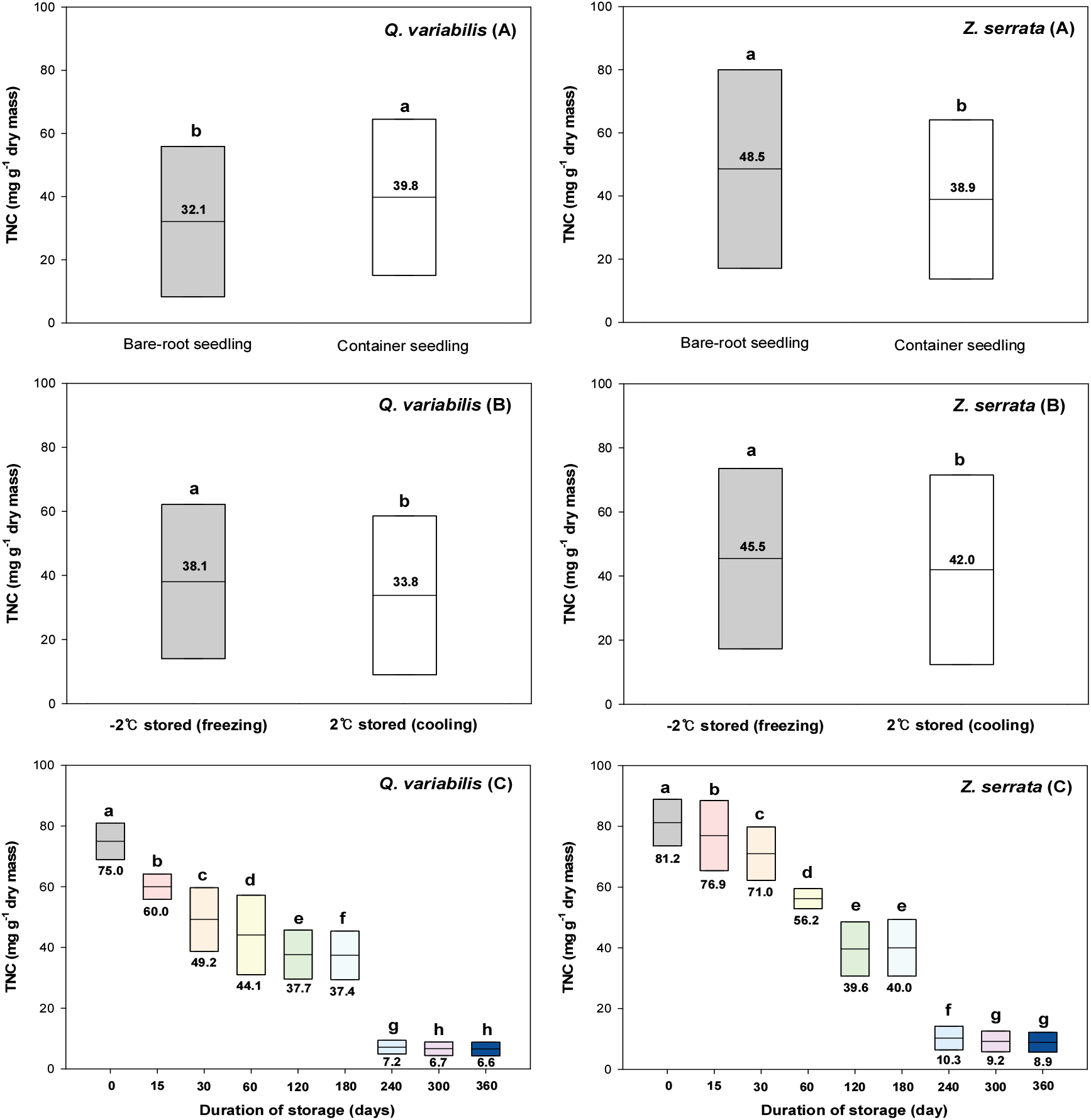
Figure 3은 저온저장 온도 및 기간에 따른 굴참나무, 느티나무 노지묘와 용기묘의 줄기함수율 변화 및 회귀식을 나타내고 있다. 묘목 저온저장 전 대비 저장 360일 동안 굴참나무는 약 40~50%, 느티나무는 20~30% 줄기함수율이 감소하였다. 두 수종 모두 노지묘보다 용기묘, 냉장(2°C)보다 냉동(−2°C) 저장 조건에서 감소율이 낮았다. 이는 전나무(Picea pungens) 5~7개월 저장이 묘목 수분함량을 10% 초과하여 감소시킨다(Lefevre et al., 1991)는 연구 결과와 저장 기간에 따른 감소율 차이는 있지만, 저장 기간이 길어질수록 줄기함수율이 감소하는 같은 경향을 보인 것이다.
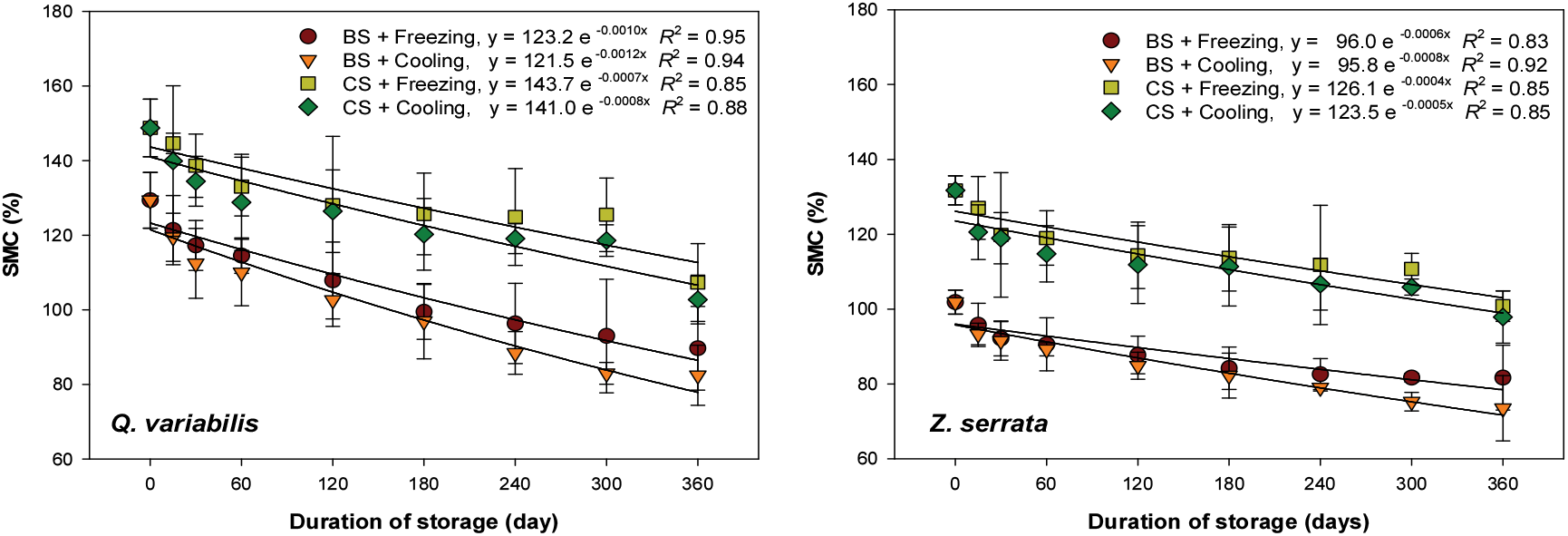
저장시설(refrigerator)을 이용한 산림용 묘목 저장은 냉각기를 이용하여 토출된 찬 바람으로 온도와 습도를 조절한다. 찬 바람에 묘목이 직접 노출되면 겨울철 한건풍과 같은 영향으로 묘목이 말라서 고사될 수 있기 때문에 상자와 보호필름을 이용하며 묘목 포장을 실시한다(Luoranen et al., 2019). 본 연구에서도 상자와 보호필름을 이용하여 묘목 포장을 실시하였지만, 저장 기간이 길어질수록 저온에 대한 수목의 방어기작에 의해 비구조성탄수화물 함량과 같이 줄기함수율이 낮아지는 결과를 보였다. 줄기의 마름 현상은 줄기와 뿌리 함수율의 감소로 이어지며, 최종적으로는 뿌리전해질침출(root electrolyte leakage)과 연계되어 줄기함수율이 낮아질수록 뿌리전해질침출은 높아지는 부의상관을 보인다(Radoglou and Raftoyannis, 2002). 저장 온도가 낮거나 기간이 길어질수록 뿌리전해질침출은 증가하고(Harper and O’Reilly, 2000), 새로운 뿌리 발생 감소로 이어져 식재 후 묘목의 생존율 및 생장 저하를 초래할 수 있다(Mckay and Mason, 1991).
두 수종 모두 저장과정에서 용기묘가 노지묘보다 유의적으로 약 20% 높은 줄기함수율을 나타냈으며(Figure 4A). 비구조성탄수화물 결과와 같이 냉장(2°C)보다 냉동(−2°C) 저장에서 높은 줄기함수율을 보였으며(Figure 4B), 저장 기간이 길어질수록 줄기함수율이 감소하는 경향을 나타냈다(Figure 4C). 선행 연구에서도 저장 기간이 길어질수록 묘목의 함수율 감소로 가문비나무(Picea sitchensis) 세근이 70%가 감소하였으며(Coutt, 1981), 소나무(Pinus nigra) 묘목의 정아 트임과 주근 생장에 부정적 영향을 주어 조림 후 활착 및 생장이 감소하였다 보고되고 있다(Girard et al., 1997).
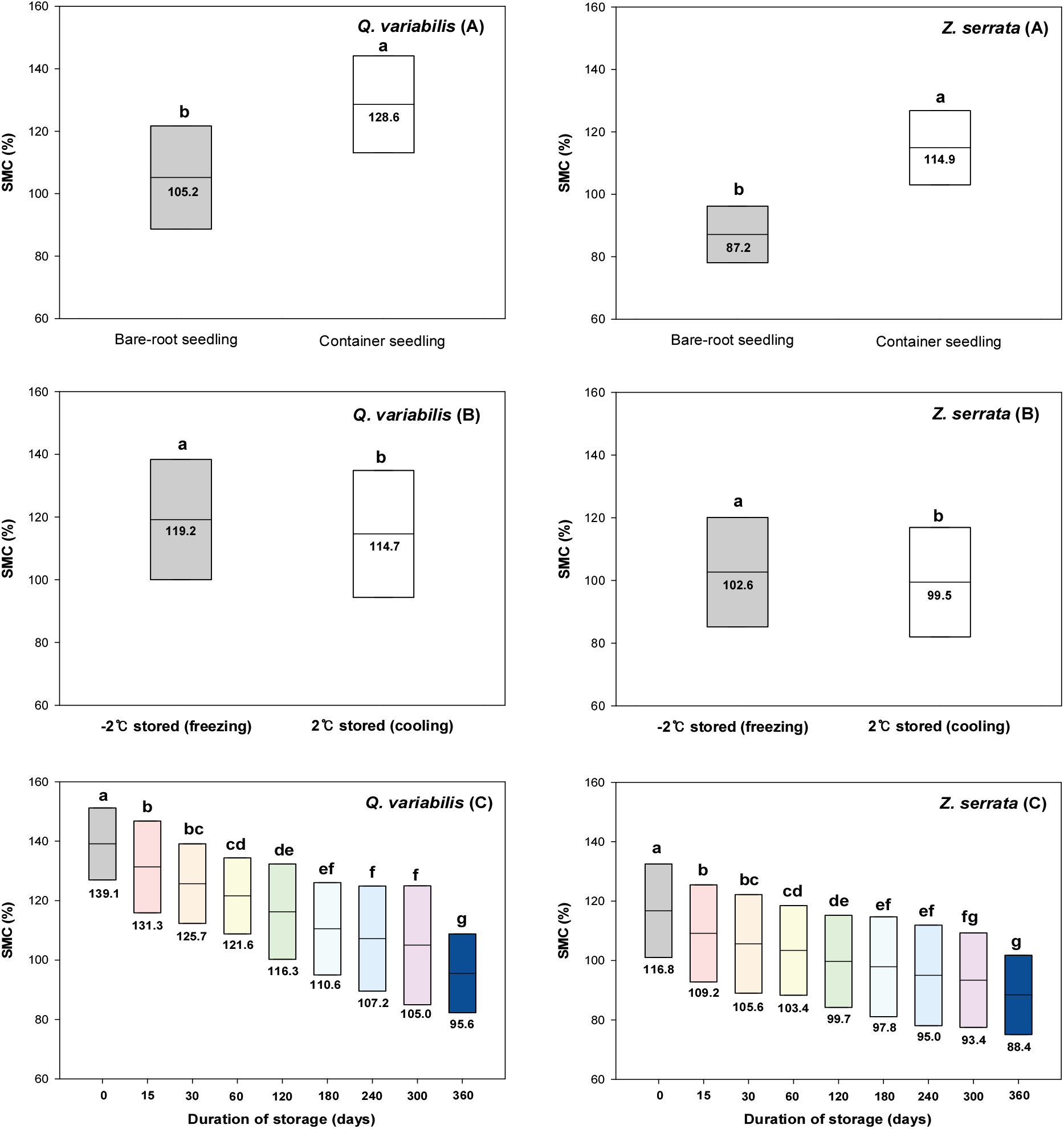
용기묘는 뿌리분(root plug)을 형성하고 있기 때문에 일반적으로 온도, 수분 등 환경 스트레스에 대한 저항성이 노지묘보다 높게 나타난다(Grossnickle and EL-Kassaby, 2016). 또한, 묘목 저장 기간이 길어질수록 용기묘와 냉동(−2°C)이 저장 저항성이 높다는 선행 연구결과(O’Reilly et al., 1999)와 생존율을 연계하여 해석할 수 있다. 이러한 묘목 종류에 따른 반응 특성은 본 저온저장 연구에서도 나타났지만, 저장 기간이 6개월 이상 길어지면, 노지묘와 용기묘 모두 묘목품질이 확연히 감소하는 것을 확인할 수 있었으며, 비구조성탄수화물 함량과 줄기함수율의 감소율은 냉동(−2°C)보다 냉장(2°C) 저장에서 높았다. 즉, 수종별 묘목 종류에 따라 저장 기간별 온도 기준 정립이 필요하며(Grossnickle et al., 2020), 향후 묘목 운반, 해동 등과 연계하여 최종적으로 조림 후 높은 생존율 및 생장이 동시에 고려된 저온저장 기준이 제시되어야 할 것으로 판단된다.
굴참나무와 느티나무의 식재 후 생존율 및 건중량은 두 수종 모두 묘목 종류, 저장 온도, 기간 등 3가지 각각의 요인별 통계적 차이를 보였다(Table 4, 5) 용기묘와 노지묘 모두 저장 60일까지는 90% 이상의 생존율을 나타냈으며, 저장과정의 비구조성탄수화물 함량과 줄기함수율 결과와 같이 저장 기간이 길어질수록 생존율이 감소하는 경향을 보였다. 용기묘가 노지묘보다 약 5~10% 높은 생존율을 보였으며, 냉동(−2°C)이 냉장(2°C) 저장 조건보다 생존율이 약 10~20% 높았다. Kerr(1994)는 참나무류(Quercus spp.)와 너도밤나무(Fagus spp.)를 4개월 동안 저온저장 후 산지에 식재하였을 시, 용기묘가 노지묘보다 생존율과 수고 생장이 각각 약 20~40%, 10~50% 높았다고 보고하였으며, 측백나무(Thuja plicata)와 솔송나무(Tsuga heterophylla)도 4~7주 동안 저장 후 용기묘가 노지묘보다 높은 뿌리생장잠재력 및 식재 후 생존율을 나타냈다(O’Reilly et al., 2001).
Values are means±SD (n=3 for survival rate, n=9 for dry weight). Values with different letters in a column indicate statistical differences among refrigerated storage treatments at the 5% levels by Duncan’s multiple range test. F values with asterisks are statistical significances in three-way ANOVA. *P≤0.05, **P≤0.01, ***P≤0.001 and NS (non-significance) = P>0.05.
Values are means±SD (n=3 for survival rate, n=9 for dry weight). Values with different letters in a column indicate statistical differences among refrigerated storage treatments at the 5% levels by Duncan’s multiple range test. F values with asterisks are statistical significances in three-way ANOVA. *P≤0.05, **P≤0.01, ***P≤0.001 and NS (non-significance) = P>0.05.
묘목 종류, 저장 온도 및 기간에 따른 굴참나무와 느티나무 건중량도 생존율 결과와 같이 용기묘와 냉동(−2°C) 저장 조건에서 우수하였으며, 저장 기간이 길어질수록 건중량 값이 낮아졌다. 그러나 묘목 종류와 저장 온도에 상관없이 두 수종 모두 저장 기간 30일과 60일은 큰 차이가 없었으며, 60일 건중량이 더 높은 경우도 있었다. 저장고는 다양한 묘목의 생리 현상을 조절하는 데에 사용될 수 있다. 저장고의 차가운 온도는 휴면기 묘목의 저온 요구도를 부분적으로 만족시킬 수 있고, 미송(Pseudotsuga menziesii)은 저온저장 처리에 의해 묘목품질이 오히려 향상되었다는 보고도 있다(Ritchie, 1989).
굴참나무와 느티나무의 식재 후 생존율은 대부분 비구조성탄수화물 함량(R2 = 0.76, 0.77, P < 0.05) 및 줄기함수율(R2 = 0.60, P < 0.05)과 정의상관을 보였지만, 느티나무의 식재 후 생존율은 줄기함수율(R2 = 0.31, P = 0.08)과 상관이 없었다. 묘목 건중량도 비구조성탄수화물 함량(R2 = 0.75, 0.72, P < 0.05) 및 줄기함수율(R2 = 0.80, 0.85, P < 0.05)과 정의상관을 나타냈다. 묘목 저장에 의해 비구조성탄수화물 함량이 20 mg m−1 이하로 감소하면, 굴참나무와 느티나무 모두 60% 이하의 식재 후 묘목 생존율을 보였다(Figure 5A). 줄기함수율이 감소하면 식재 후 생존율이 감소하는 경향을 나타냈다(Figure 5B). 비구조성탄수화물 함량이 약 30% 감소 시 묘목 건중량이 약 50% 감소하였고(Figure 6A), 줄기함수율이 약 20% 감소 시 묘목 건중량이 약 50% 감소하였다(Figure 6B).
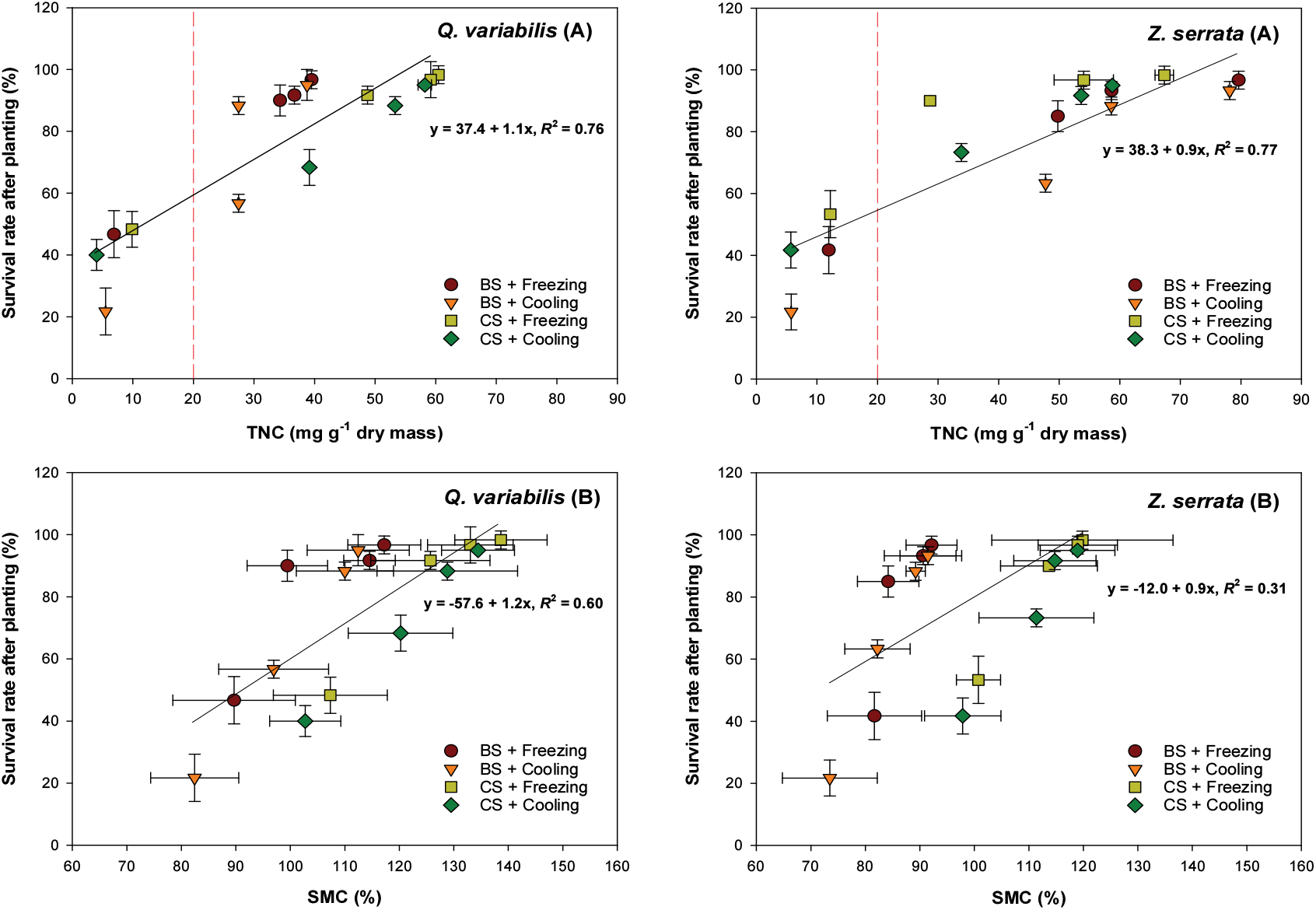
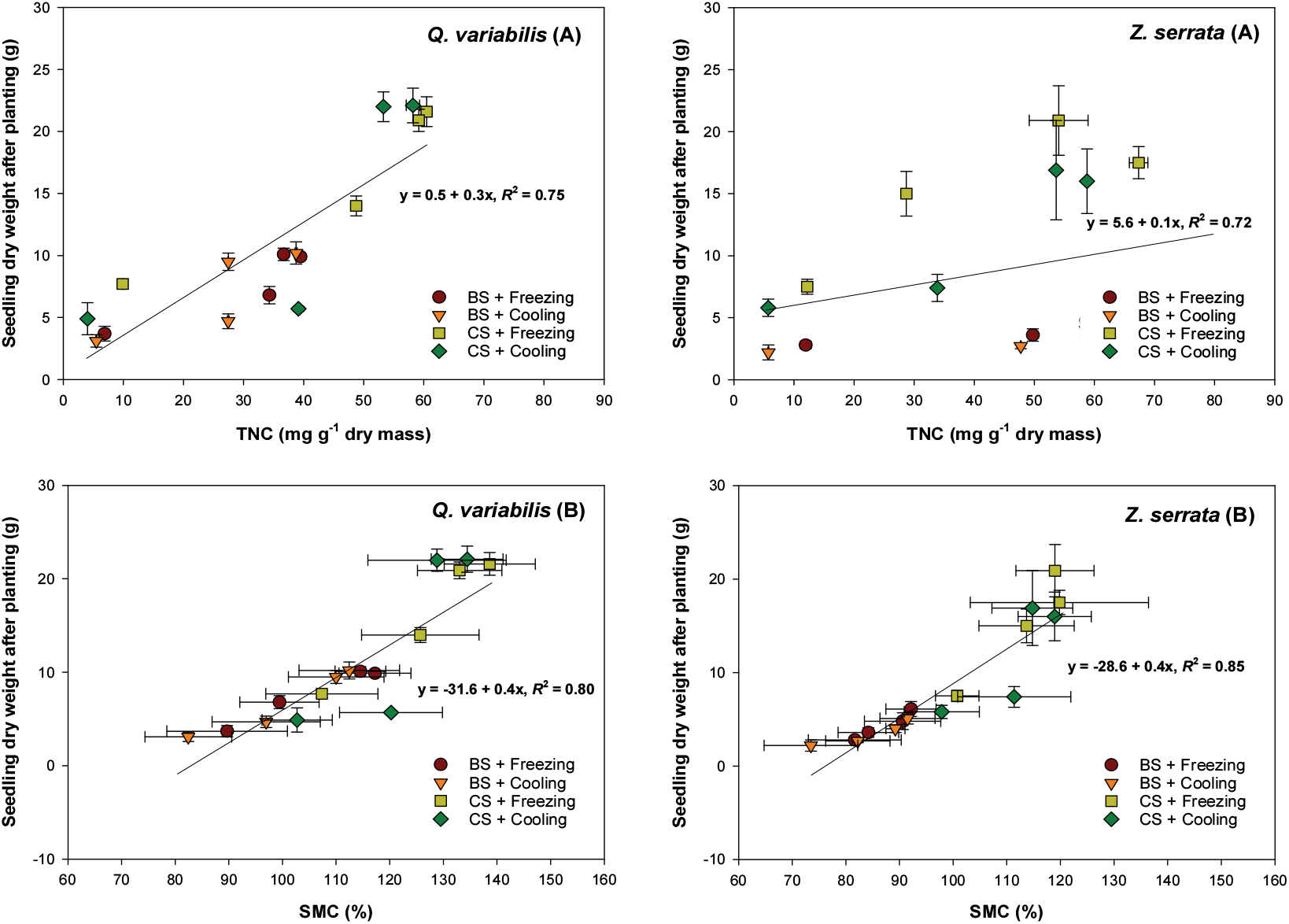
비구조성탄수화물은 삼투압 조절, 산화 스트레스 복구 및 방어에 관여하며, 수목의 건조에서 살아남기 위한 중요한 생리 방어기작의 원천이다(Chaves et al., 2003; Salleo et al., 2004). 이러한 생리적 유지 대사 과정에 대한 비구조성탄수화물의 수요는 수목의 잠재 생장을 제한 할 수 있다(McDowell, 2011; Sevanto et al., 2014). 즉, 저온저장에 의한 묘목 마름과 건조 스트레스에 의해 비구조성탄수화물이 고갈되며, 뿌리 또는 줄기로의 이동 능력을 제한하여 묘목품질의 저하와 식재 후 고사율 증가가 나타나는 것이다.
Puttonen(1986)은 소나무(Pinus. sylvestris)가 장기 저장에 따라 비구조성탄수화물이 감소하고, 식재 후 묘목 고사율이 증가하였다고 보고하였다. 그러나 묘목의 비구조성탄수화물과 식재 후 생존율은 선형관계가 아니며, 비구조성탄수화물이 임계점(total glucose 2% dry mass)에 도달하기 전까지는 생존율 저하가 발생하지 않음을 밝혔다. 임계점 이상의 비구조성탄수화물 묘목은 고사율이 10% 이하였지만, 임계점 이하에서는 생존율이 급격히 감소하며 30~50%의 고사율을 나타냈다. 그러나 과거 식재 후 묘목 고사에 대한 비구조성탄수화물 역할의 상황적 증거 연구는 많이 이루어졌지만, 고사의 주 원인임을 입증하는 데는 많은 혼란이 있었다. 최근 건조 스트레스와 연계하여 묘목의 생존 능력이 변화된다는 연구를 통해 비구조성탄수화물과 묘목 생존율의 관계가 구명되었다(Hartmann et al., 2013; Mitchell et al., 2013; O’Brien et al., 2014).
저장 방식에 따른 차이는 있지만, 가문비나무(Picea mariana) 줄기함수율이 10% 감소 시, 식재 후 생존율이 약 40~70% 감소하였으며(Colombo, 1990), 활엽수 9수종(Acer pseudoplatamus 등)은 줄기함수율 10% 감소 시, 식재 후 생존율이 약 2~5% 감소하였다(Radoglou and Raftoyannis, 2002). 비구조성탄수화물과 같이 묘목 저온저장과정에서의 묘목품질과 조림 후 활착 및 생장에 문제가 없는 수종별 묘목 마름과 관련한 함수율 임계점을 구명하고(Mckay and White, 1997), 이에 맞는 수종별 저온저장 기준이 제시되어야 한다. 본 연구에서는 저장 전 줄기함수율 기준으로 굴참나무는 약 30%, 느티나무는 약 20% 감소 시 생존율이 80% 이하로 나타났으며, 그 이상의 줄기함수율 감소는 식재 후 조림 성과에 문제가 있을 것으로 판단된다.
결 론
본 연구는 월동과정에서 묘목 피해를 최소화할 수 있는 저장기술 개발을 위해 묘목 저장 적정 온도 및 기간을 구명하고자 수행되었다. 굴참나무와 느티나무 노지묘 및 용기묘를 대상으로 저온저장 온도(냉동 −2°C, 냉장 2°C)와 기간(0, 15, 30, 60, 120, 180, 240, 300, 360일)에 따른 묘목의 비구조성탄수화물 함량 및 줄기함수율과 식재 후 묘목 생존율 및 건중량을 조사·분석하였다.
굴참나무와 느티나무 두 수종 모두 저장 기간이 길어질수록 비구조성탄수화물 함량과 줄기함수율이 감소하였으며, 180~240일 이후 비구조성탄수화물 함량이 급격히 감소하는 것을 확인하였다. 또한, 두 수종 모두 냉장 저장은 60일, 냉동 저장은 180일 이후 식재 후 생존율이 급격히 감소하였다. 저장 기간이 길어질수록 냉장보다는 냉동 조건이 낮은 묘목품질 감소율과 높은 식재 후 생존율과 생장을 보였으며, 냉동 조건이 장기 저장에 적합한 것으로 판단된다.
저장 온도 및 기간에 따른 묘목의 비구조성탄수화물 함량과 줄기함수율의 감소에 의한 묘목품질의 저하가 식재 후 묘목 생존율과 생장 특성에 미치는 부정적 영향을 확인할 수 있다. 최종적으로 저장과정에서의 비구조성탄수화물 및 줄기함수율과 식재 후 생존율 및 생장을 기준과 함께 해동, 운반 및 저장 관련 양묘장 운영 비용 등을 동시에 고려하여 묘목 저장은 온도 및 기간에 따라 냉장과 냉동 두 가지 저장 방식으로 나눌 수 있다. 굴참나무와 느티나무 묘목의 저장 방식으로 2개월 미만의 단기저장은 냉장(1 ~2°C), 2~6개월 동안의 장기저장은 냉동(−2~−4°C)이 적정한 것으로 판단된다. 또한, 노지묘가 용기묘보다 저장에 대한 적응성이 낮기 때문에 노지묘 장기 저장은 지양해야 할 것이다. 향후 조림 전 묘목 수확 및 관리 시스템과 연계하여 적정 묘목 저장 조건의 적용은 우수한 품질의 묘목 생산과 함께 조림 성과 향상을 기대할 수 있을 것이다.






